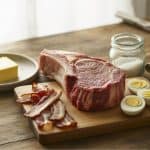Carnivore vs Ketovore vs Keto: What’s the Difference?
If you’ve been exploring low-carb lifestyles, you’ve probably come across terms like Keto, Ketovore, and Carnivore and maybe wondered, aren’t they all kind of the same thing? Not quite. While these three diets share a foundation of cutting carbs and embracing healthy fats and proteins, they each have their own focus, food rules, and benefits.
The Keto Diet emphasizes keeping your body in ketosis by eating low-carb but still allows plenty of plant foods. The Ketovore Diet leans heavily toward animal-based eating with a little flexibility for low-carb veggies or berries. And the Carnivore Diet takes it to the simplest, most nutrient-dense extreme 100% animal foods, zero carbs.
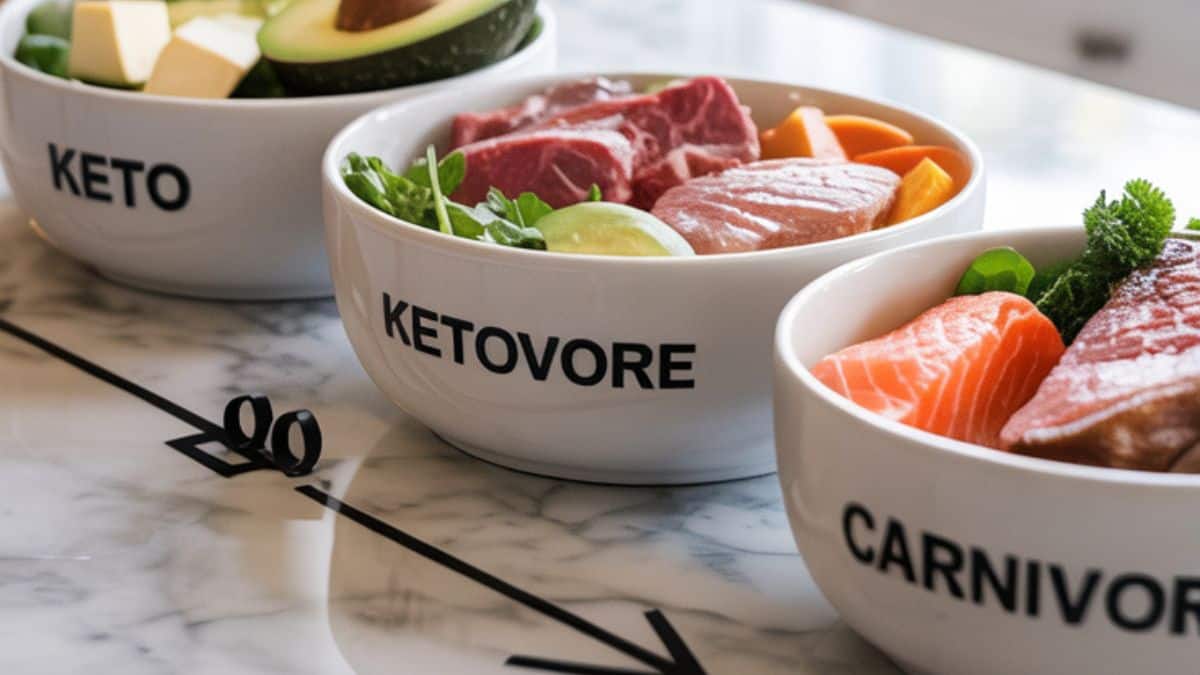
Whether you’re looking to lose weight, improve energy, or tackle inflammation and autoimmune symptoms, understanding these differences can help you choose the approach that fits your goals and lifestyle best.
In this guide, we’ll break down Keto vs Ketovore vs Carnivore what you can eat on each, how they affect your body, and which one might be the right next step in your low-carb journey.
Quick Overview: How These Diets Compare at a Glance
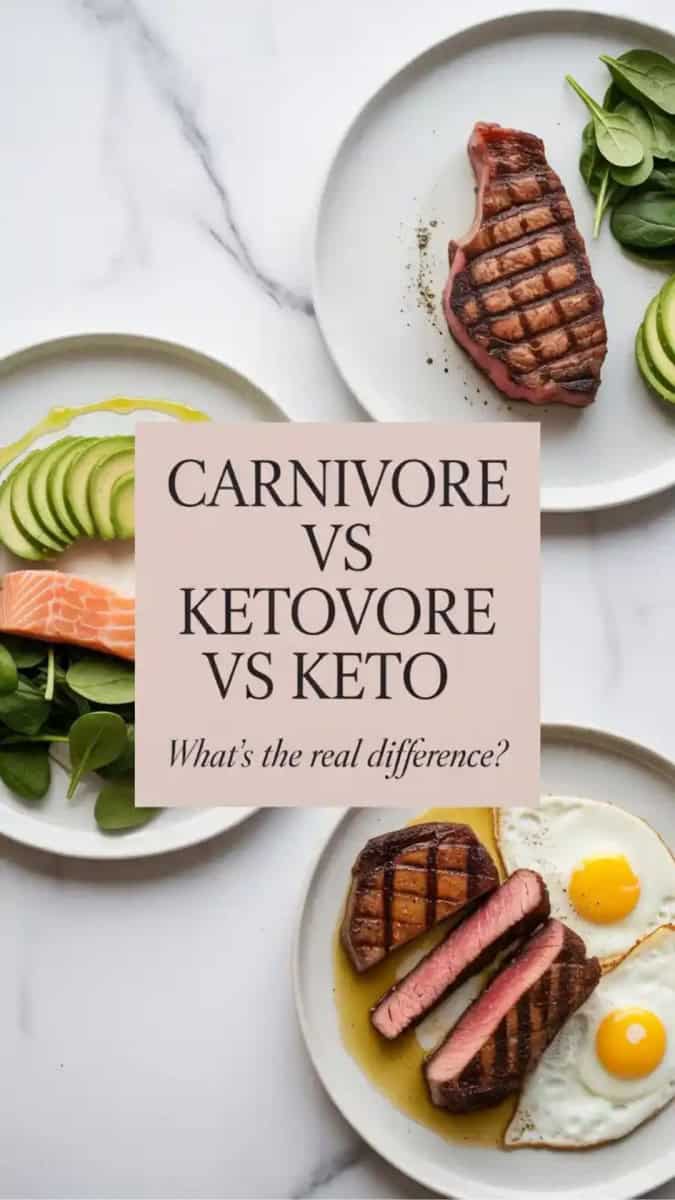
Before diving into the details, let’s look at how Keto, Ketovore, and Carnivore stack up side by side. While they all focus on reducing carbs and using fat for fuel, each one takes a slightly different approach to what’s on your plate.
Here’s a quick snapshot:
| Feature | Keto Diet | Ketovore Diet | Carnivore Diet (Affiliate) |
|---|---|---|---|
| Primary Goal | Stay in ketosis for fat-burning and stable energy | Transition toward animal-based eating while maintaining mild ketosis | Full elimination of plant foods to heal inflammation and optimize digestion |
| Typical Macros | ~70–75% fat, 20–25% protein, 5–10% carbs | ~75–80% fat, 20–25% protein, <5% carbs | ~80% fat, 20% protein, 0% carbs |
| Plant Foods | Allowed (low-carb veggies, nuts, berries) | Minimal (small servings of avocado, spinach, or herbs) | None (strict) |
| Animal Foods | Meat, eggs, seafood, dairy, butter | Mostly animal-based with occasional low-carb produce | Only meat, fish, eggs, and animal fats |
| Carb Intake | Typically 20–50g net carbs/day | Usually under 10–20g carbs/day | Zero carbs |
| Fiber | Moderate | Very low | None |
| Common Benefits | Weight loss, mental clarity, blood sugar balance | Fat adaptation, digestive improvement, easier transition to Carnivore | Reduced inflammation, gut healing, elimination of food sensitivities |
| Ideal For | Those wanting flexibility and variety | Those easing into Carnivore or wanting a balance | Those with autoimmune, digestive, or inflammation issues |
| Difficulty Level | Moderate | Moderate–High | High |
Think of Keto as your flexible low-carb lifestyle, Ketovore as your animal-based balance, and Carnivore as your ultimate elimination diet. Each can serve a different purpose depending on where you are in your health journey.
What Is the Keto Diet?
The Basics
The Keto Diet (short for “ketogenic”) is all about shifting your body’s main fuel source from carbohydrates to fat. By keeping carbs very low and eating plenty of healthy fats, your body enters a state called ketosis, where it burns fat for energy instead of glucose.
It’s not a high-protein diet rather, it’s a high-fat, moderate-protein, low-carb plan designed to maintain steady blood sugar, promote fat loss, and increase mental focus.
What You Eat
Keto allows a variety of both animal and plant-based foods, as long as carbs stay low.
Typical foods include:
- Fatty cuts of beef, chicken, or pork
- Eggs and seafood
- Healthy fats like butter, olive oil, and coconut oil
- Low-carb vegetables such as spinach, zucchini, cauliflower, and broccoli
- Small portions of nuts, seeds, and berries
- Dairy products like cheese, cream, and yogurt (in moderation)
(Optional affiliate note: “You can make staying in ketosis easier with a quality MCT oil or electrolyte supplement — both available on Amazon.”)
Common Benefits
- Steady energy levels without sugar crashes
- Weight loss and improved fat metabolism
- Sharper mental clarity
- Better control over hunger and cravings
- Balanced blood sugar and insulin levels
Potential Drawbacks
While Keto can feel freeing compared to standard diets, it can still include foods that cause inflammation for some people especially those sensitive to dairy, nuts, or plant-based oils.
Some also find Keto too flexible when trying to heal autoimmune or digestive issues, which is where Ketovore or Carnivore can step in.
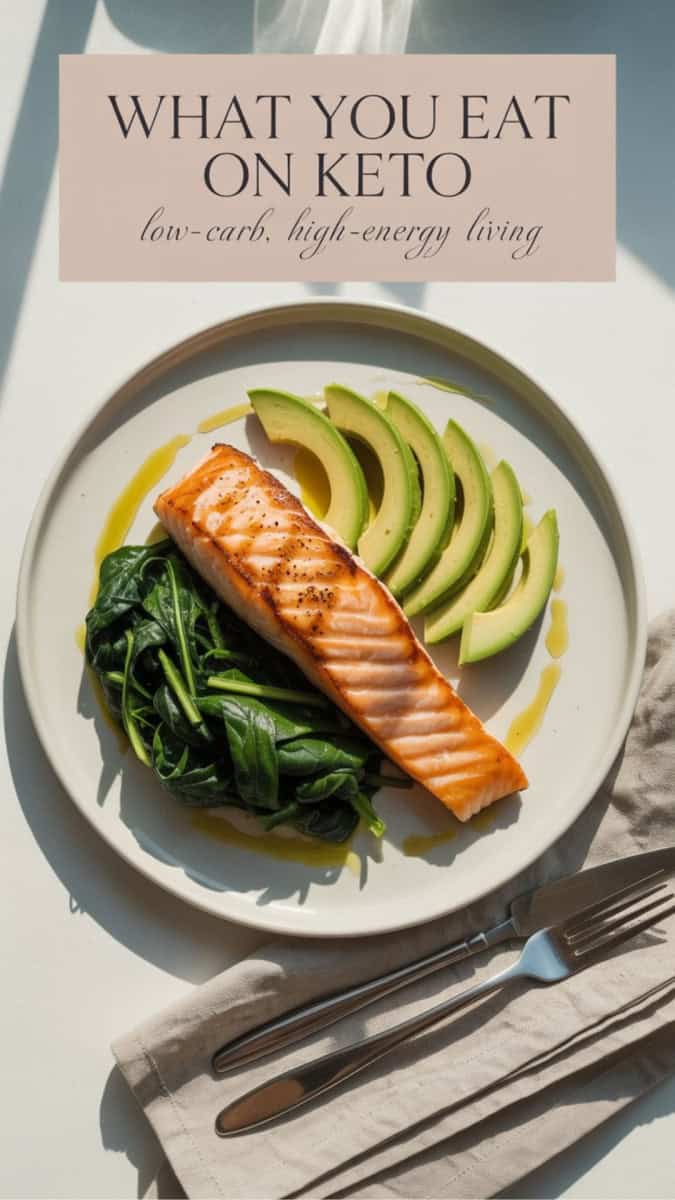
What Is the Ketovore Diet?
The Middle Ground
The Ketovore Diet is the perfect balance between Keto and Carnivore it keeps your body fat-fueled but leans more heavily on animal foods. Think of it as a low-carb lifestyle with a carnivore emphasis. You’ll still enjoy the benefits of ketosis but with fewer plant-based foods to cause digestive irritation or inflammation.
This diet appeals to people who want to simplify what they eat without going fully meat-only. It’s also an excellent “bridge” for anyone easing into the Carnivore lifestyle.
What You Eat
Ketovore keeps things simple primarily meat, eggs, and animal fats with just a sprinkle of low-carb plants if desired.
Typical foods include:
- All meats: beef, pork, lamb, poultry, and seafood
- Eggs, butter, and ghee
- Hard cheeses and full-fat dairy (if tolerated)
- Animal fats such as tallow or duck fat
- Small amounts of avocado, spinach, or herbs for flavor
- Occasional low-sugar fruits like a few berries
This mix keeps carbs extremely low while giving a touch of flexibility.
Common Benefits
- Easier transition from Keto to Carnivore
- Fewer cravings and blood sugar swings
- Improved digestion and gut health
- More nutrient-dense meals with less tracking
- Great for long-term fat adaptation
Potential Drawbacks
While Ketovore offers more freedom than strict Carnivore, that flexibility can backfire.
A handful of berries or too much dairy can quickly knock you out of ketosis.
If you have autoimmune or gut issues, even small amounts of plants may still cause inflammation.
Quick Tip
Many Carnivore beginners start with a Ketovore phase cutting back on plant foods while keeping meals enjoyable. Over time, they often find it easier to transition to fully Carnivore if their body thrives on simplicity.
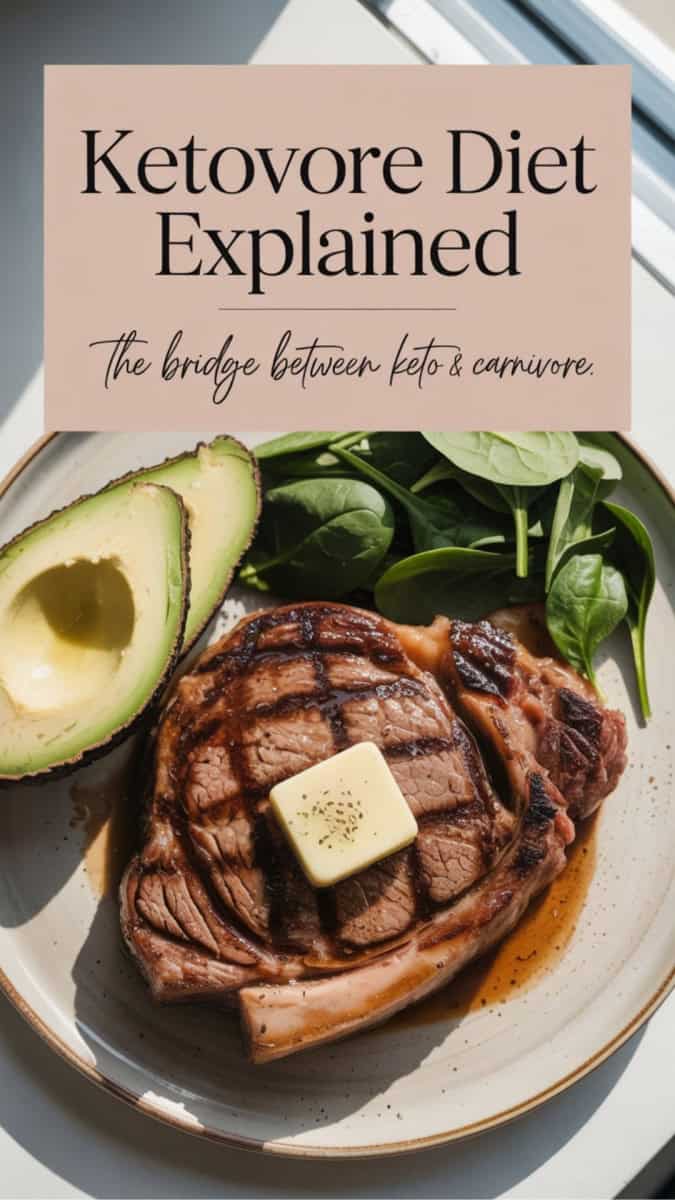
What Is the Carnivore Diet?
The Ultimate Elimination Diet
The Carnivore Diet takes low-carb eating to its purest form 100% animal-based.
No plants, no fiber, no sugar just nutrient-dense foods from the animal kingdom.
The idea is to eliminate all potential irritants and focus on foods that are easy to digest, anti-inflammatory, and rich in the vitamins and minerals your body actually uses.
Many people turn to Carnivore to address autoimmune conditions, gut issues, fatigue, or stubborn inflammation that didn’t fully improve on Keto or Ketovore.
It’s simple, satisfying, and surprisingly sustainable once you learn what your body needs.
What You Eat
The goal is simplicity and nourishment nothing processed, nothing that spikes insulin.
Typical foods include:
- Ruminant meats like beef and lamb (the foundation of most meals)
- Pork, chicken, duck, and other poultry
- Fatty fish and shellfish
- Eggs and egg yolks
- Animal fats such as tallow, butter, and ghee
- Optional: cheese or cream (if tolerated), coffee, and minimal seasonings
See my full Carnivore Diet Food List for details.
Common Benefits
- Noticeable reduction in inflammation and bloating
- Clearer skin and improved digestion
- Easier weight management and stable energy
- Mental focus and mood stability
- Relief from autoimmune or chronic pain symptoms
Potential Drawbacks
- Can be socially restrictive dining out may take planning
- May cause temporary adaptation effects (fatigue, headaches, electrolyte imbalance)
- Requires extra attention to hydration and salt intake
- Limited food variety can be challenging for beginners
(Internal link tip: add “Learn more in Common Carnivore Diet Mistakes (and How to Avoid Them).”)
Pro Tip
Start with fatty red meats like ribeye, ground beef, or lamb chops they’re rich in nutrients and keep you full without constant snacking. Over time, you can experiment with organ meats or add eggs and seafood for variety.
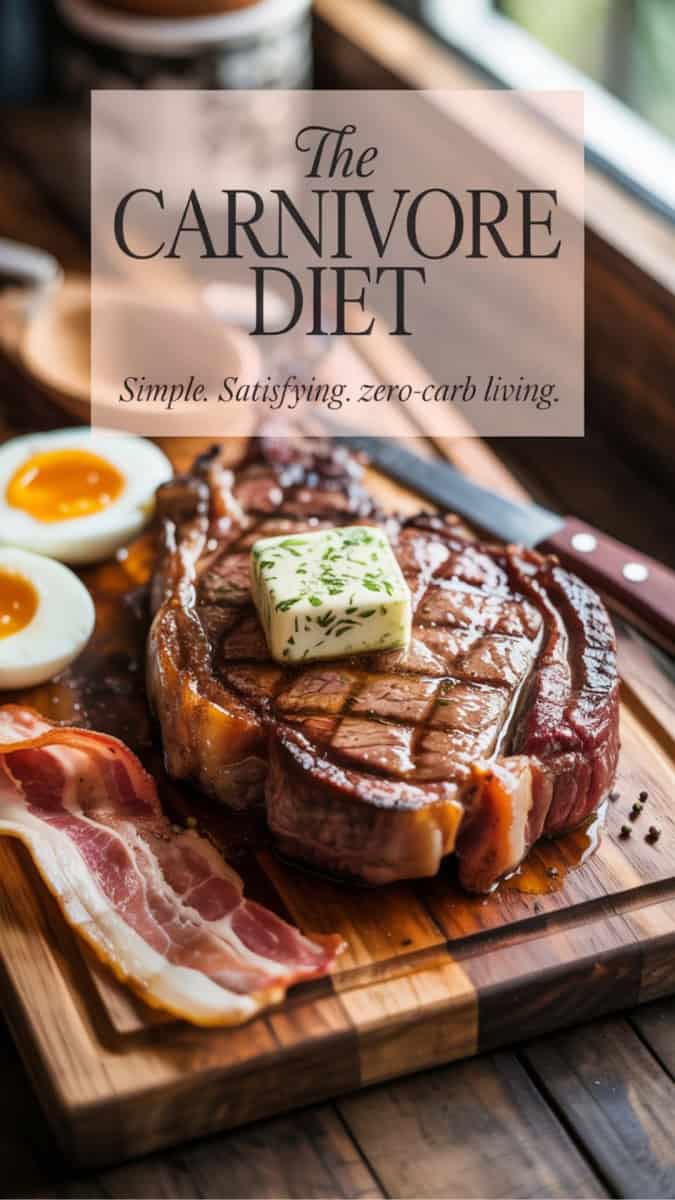
Side-by-Side Comparison: Keto vs Ketovore vs Carnivore
When you put these three diets next to each other, the differences become much clearer.
All focus on reducing carbs and improving metabolic health but how far you take that depends on your personal goals, food sensitivities, and how your body responds to certain ingredients.
a. Macronutrient Breakdown
Here’s a general idea of how the macros typically line up:
| Diet | Fat (%) | Protein (%) | Carbs (%) |
|---|---|---|---|
| Keto | 70–75% | 20–25% | 5–10% |
| Ketovore | 75–80% | 20–25% | <5% |
| Carnivore | 80% | 20% | 0% |
Each plan runs on fat as the main energy source, but Keto allows more carbohydrates through low-carb veggies and nuts, while Carnivore cuts them entirely.
b. Plant vs Animal Food Ratio
- Keto: roughly 60–70% animal-based and 30–40% plant-based
- Ketovore: around 90–95% animal-based, 5–10% plant-based
- Carnivore: 100% animal-based, with zero plant foods
The fewer plants you include, the simpler digestion becomes which is why many people with autoimmune or gut issues gravitate toward Ketovore or Carnivore.
c. Fiber, Carbs & Ketosis Impact
- Keto: You stay in ketosis if carbs are limited and portioned carefully.
- Ketovore: Easier to stay in ketosis, as most foods are naturally zero-carb.
- Carnivore: Always in ketosis (fat-fueled 24/7) due to total carb elimination.
(Note: Carnivore can produce deeper ketosis levels but tends to feel steadier because your body adapts to using fat full-time.)
d. Lifestyle Difficulty
| Category | Keto | Ketovore | Carnivore |
|---|---|---|---|
| Meal Variety | High | Medium | Low |
| Ease of Dining Out | Easy | Moderate | Challenging |
| Social Flexibility | Easy | Medium | Harder |
| Adaptation Period | Mild | Moderate | Intense (initially) |
| Maintenance | Sustainable long-term | Very sustainable | Highly individual |
Quick Summary
- Keto = flexible and beginner-friendly
- Ketovore = balanced and fat-adapted
- Carnivore = simplified and therapeutic
They can even flow naturally in a progression — Keto → Ketovore → Carnivore — as your body adjusts and your goals evolve.
Which Diet Is Best for You?
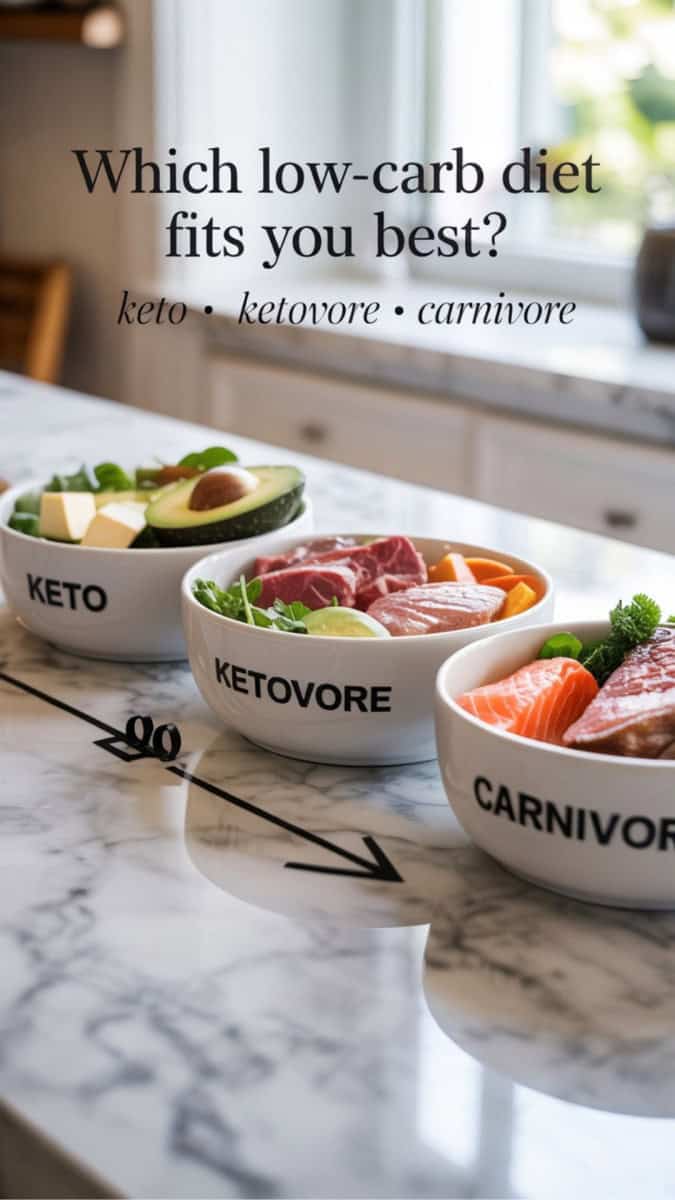
Choosing between Keto, Ketovore, and Carnivore really comes down to your goals, how your body responds to certain foods, and what kind of lifestyle you can maintain long-term.
Each diet can be effective but they serve different purposes depending on where you are in your health journey.
If Your Goal Is Weight Loss and Flexibility
Start with Keto.
It’s the most versatile option and easier to fit into everyday life. You’ll still enjoy vegetables, cheese, and even the occasional low-carb dessert while training your body to burn fat for energy.
Best for: Beginners, families, and anyone wanting steady energy without cutting out all plants.
If Your Goal Is Fat Adaptation or Gut Health
Move toward Ketovore.
This approach gives you the benefits of Keto without the plant-heavy load that can irritate digestion. You’ll eat mostly animal-based foods with just a few low-carb plants if you tolerate them well.
Best for: People ready to simplify their diet, reduce cravings, or transition into Carnivore.
If Your Goal Is Healing, Energy, and Inflammation Control
Go full Carnivore.
This diet is a nutritional reset removing every potential irritant and letting your body heal through simplicity and nourishment. Many find relief from autoimmune issues, joint pain, or chronic fatigue here.
Best for: Those with autoimmune, inflammatory, or digestive problems, or anyone ready for a clean-slate approach to food.
Transition Path: How to Progress Naturally
You don’t have to jump straight into Carnivore overnight. Many people move through the phases like this:
Keto → Ketovore → Carnivore
Each step lowers carb intake and plant foods gradually, allowing your metabolism and digestion to adjust smoothly.
(Optional visual prompt: Create a simple arrow graphic or flow chart showing this path.)
Tip for All Three Diets
No matter where you land, focus on quality foods grass-fed beef, pastured eggs, wild-caught fish, and pure animal fats. Stay hydrated, get electrolytes, and listen to your body’s feedback.
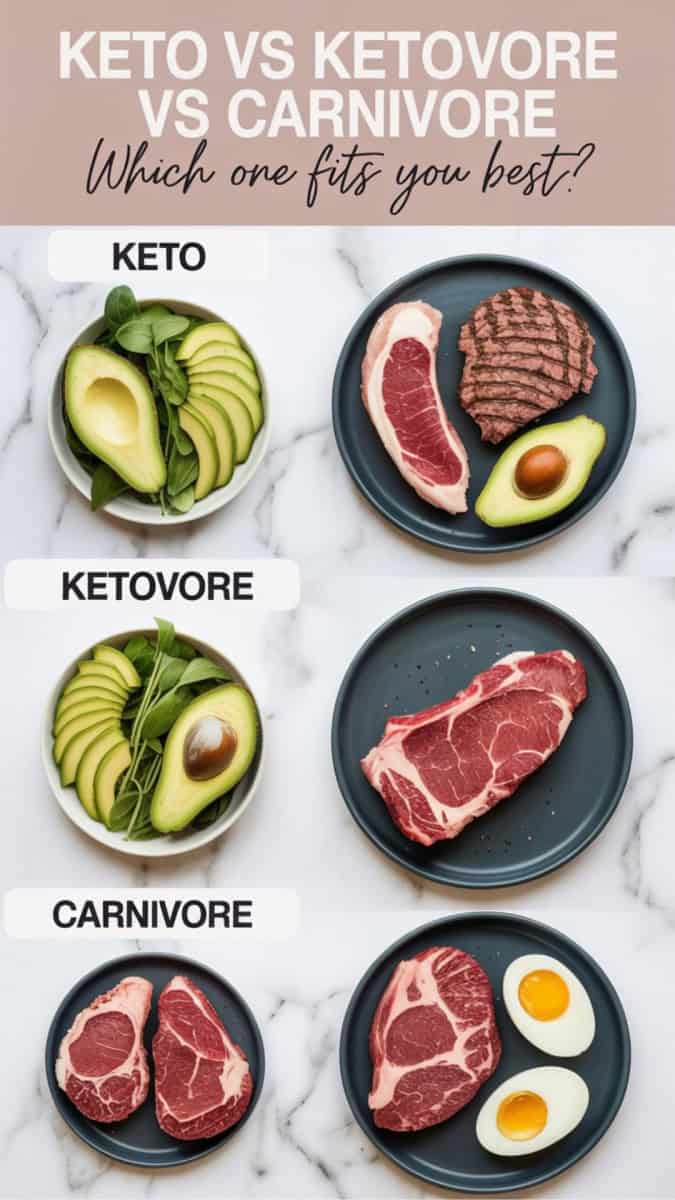
Final Thoughts: Finding What Works for Your Body
At the end of the day, all three diets Keto, Ketovore, and Carnivore share the same foundation: real food, fewer carbs, and a return to nutrient-dense eating. The right one for you depends on your current health, goals, and how your body feels on each approach.
You don’t have to commit to one forever. Many people start with Keto to ease into fat adaptation, transition to Ketovore for simplicity, and explore Carnivore when they’re ready to reset and heal deeper issues.
What matters most is learning to listen to your body. If a food causes inflammation, cravings, or fatigue it’s not serving you.
Experiment, take notes, and move at your own pace.
And if you ever need inspiration for delicious, simple recipes that fit any of these plans, explore my Carnivore Recipe Collection from hearty flatbreads to satisfying soups, it’s all about making this lifestyle enjoyable and easy to sustain.
FAQs About Keto, Ketovore, and Carnivore
Can you go in and out of ketosis on Ketovore?
Yes. Because Ketovore allows small amounts of low-carb plant foods, it’s possible to move in and out of ketosis depending on your carb intake. Most people naturally stay in mild ketosis on this diet, especially if their meals are primarily meat and fat-based.
Is dairy allowed on the Carnivore Diet?
That depends on your goals and how your body reacts.
Some people tolerate dairy well and include butter, cheese, and cream, while others find it triggers inflammation or stalls fat loss. If you’re starting out, try a few weeks without dairy and reintroduce it later to see how you feel.
Can I build muscle on the Carnivore or Ketovore Diet?
Absolutely. Both diets are naturally high in protein and rich in nutrients that support muscle growth and recovery. Focus on fatty meats like ribeye, eggs, and ground beef for balanced fat-to-protein ratios and don’t skimp on salt and hydration, which are crucial for performance.
How long should I stay on each diet?
There’s no one-size-fits-all rule.
- Keto can be a sustainable long-term lifestyle.
- Ketovore is ideal for people who want flexibility while staying mostly animal-based.
- Carnivore can be followed short-term as a healing phase or maintained long-term if it suits your body.
Listen to your body, track how you feel, and adjust over time.
What about electrolytes do I need supplements?
Yes, especially during the first few weeks. When carbs are low, your body releases water and sodium more quickly. Replenishing sodium, potassium, and magnesium can prevent fatigue, headaches, or cramps. Bone broth, mineral salts, or electrolyte powders are great additions.
Can I drink coffee or tea on the Carnivore Diet?
Technically, no they come from plants. But many people choose to keep them in moderation, especially during transition phases. If you notice bloating, anxiety, or poor sleep, try cutting back and see if it helps.
Which diet is easiest to start with?
Keto is the most beginner-friendly because it offers flexibility and variety. Once you feel comfortable eating high-fat and low-carb, transitioning to Ketovore or Carnivore becomes much easier.
Carnivore Diet Guides
Check out more information about a meat based or carnivore diet!
One-Pot Cooking Rocks!

Michelle
Hi, I’m Michelle, the founder, owner, author, and editor of OvenSpot. My passion for one-pot cooking commenced when I was working to prepare cafeteria lunches for school students. I am now on a mission to assist you in choosing the cooking pot or appliance you will use daily. As well as in-depth information to assist you in using and caring for your cookware and appliances. Along with the yummy recipes I use at home.
Questions? Reach out to Michelle at [email protected]

